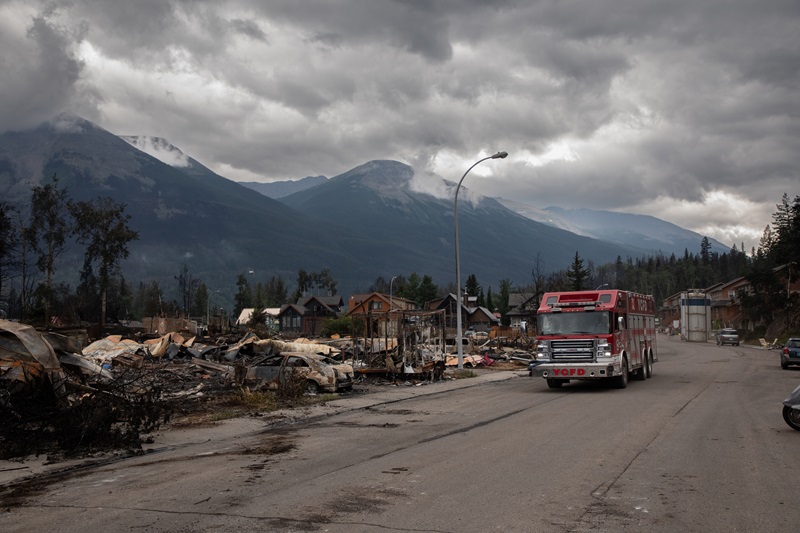‘Extra hoops’: Parks Canada’s lease system, building rules could delay Jasper rebuild

JASPER, Alta. — Residents of Jasper, Alta., who lost their homes in last month’s wildfire face unique rebuilding challenges tied to leasing provisions nearly as old as Canada, as well as modern rules dictating what they can and can’t construct.
Lawyer Jessica Reed said property owners in the townsite in Jasper National Park, unlike in other municipalities, don’t own the land they sit on.
“The actual owner of the land, even if you looked at the land title, is the King himself,” said Reed, a partner with a firm that has offices in four Rocky Mountain municipalities, including Jasper.
This means that each property owner in Jasper, like those in other communities located within a national park, is a leaseholder with the Crown. They also don’t technically own their homes, Reed said, as the buildings are part of the lease.
The Canada National Parks Act also stipulates the leases are usually for 42-year terms, although some are shorter, and renewing involves renegotiating terms of the leases.
Reed said this has already caused headaches for Jasper homeowners, as banks sometimes refuse to issue mortgages if the existing lease on a property is shorter than the prospective mortgage term.
That problem could become much bigger, given 358 homes and businesses in the town of 5,000 people were recently levelled by fire, she said.
She’s concerned the leases may impede rebuilding efforts and potentially cause financial harm.
Residents and all park visitors were forced to leave on the night of July 22. They remain out and, although the fire is extinguished in town, crews are still fighting flames in the park.
Reed said those who don’t want to rebuild may also face challenges.
There have been instances in the past where property owners have taken insurance payouts after their homes were destroyed, rather than electing to rebuild, only to be blocked by Parks Canada from selling the vacant land to a prospective buyer, she said.
“One owner wanted to take a buyout and then just sell the vacant lot. And Parks Canada said ‘No, you cannot sell a vacant lot. You need to sell a new build,’” Reed said.
“What I’m freaked out about here is people are a couple weeks into talking with their adjusters and they’re looking at their buyout values, and they’re thinking, ‘That sounds good.’”
Historian Alan MacEachern with Western University said the lease system dates back to the 1880s, shortly after Canada’s first prime minister, John A. MacDonald, and the federal government took inspiration from the United States and made Banff National Park the country’s first.
At the time, MacEachern said MacDonald wanted to make sure leases were given to the wealthy to ensure buildings in Banff, Alta., were as remarkable as the scenery.
Over the years, the government made many changes to the system, MacEachern said, such as lengthening the lease terms to 42 years from the original 21 and introducing renewable leases, but shortly after made them non-renewable again.
MacEachern said the upshot is leaseholders feel the government has too much power, while Ottawa is concerned it gave up too much control.
“Basically, they set up a system in the late 1800s and early 1900s that on the one hand helped create Banff and other places but in a way made nobody happy,” MacEachern said.
Nowadays, these leases don’t necessarily govern the day-to-day lives of park residents, Reed said, but they’re “powerful,” frustrating documents.
“At the end of the day, for the person that’s actually buying a house, it looks normal,” she said. “It’s the lawyers — we pull our hair out.”
Once the lease problems are solved, Jasper homeowners need to follow two sets of rules for rebuilding.
The town’s land use policy dictates what kinds of buildings can be built and where. And Parks Canada’s building regulations covers things like acceptable home exterior colours and roofing materials.
Reed said the fire has no effect on the leases that Jasper residents hold, but rebuilding will require getting all the necessary Parks Canada approvals, just like they need for home renovations.
“It’s a pretty slow process to get development approved,” she said.
However, Reed added that she’s confident Parks Canada will be flexible in the months and years to come. And officials have indicated as much.
This week, Jasper Mayor Richard Ireland and Parks Canada officials told a town hall for evacuees that an exemption will be made to the rule outlawing new mobile homes in Jasper for those who lost their mobile homes to the fire.
Both Parks Canada and the Ministry of Environment and Climate Change, which is responsible for Parks Canada, did not respond to emailed questions about leases and rebuilding in Jasper.
– This report by The Canadian Press was first published Aug. 9, 2024.
This is a corrected story. A previous version said Jasper property owners own their homes, but technically the buildings are covered under leases.
Photo Credit: A fire truck travels past a devastated residential block in Jasper, Alta., on Friday July 26, 2024. Jasper residents who lost their homes in last month’s wildfires face unique rebuilding challenges tied to leasing provisions nearly as old as Canada is, followed by two sets of modern rules dictating what they can and can’t construct. THE CANADIAN PRESS/Amber Bracken







